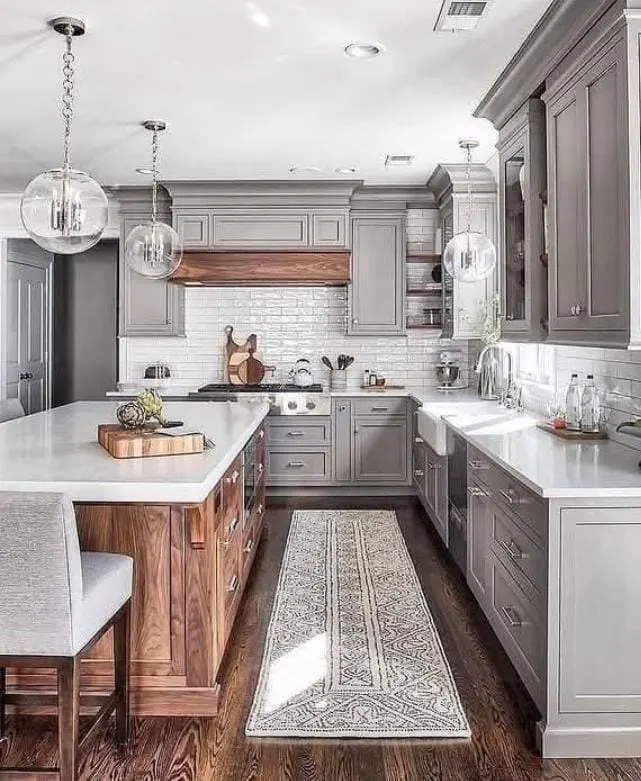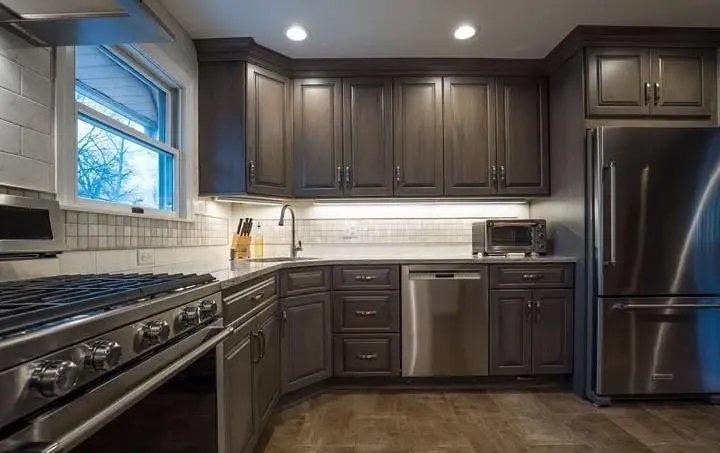20 Trendy Earthy Kitchen Ideas For A Warm,Inviting Cooking Space That Warm up A Dull Kitchen
There’s something magical about an earthy kitchen — a space that feels grounded, soulful, and warm without even trying. It’s where natural textures meet calming tones, where every surface whispers a story, and where design feels effortless yet deeply personal.
Whether you live in a cozy cottage or a modern apartment, embracing earthy kitchen ideas can bring a sense of comfort that feels timeless and relaxed. The beauty of an earthy design is that it never screams for attention — it quietly inspires through its balance of simplicity, texture, and warmth.
From clay-toned tiles to rustic wood counters and open shelves styled with pottery, an earthy kitchen captures the essence of slow living. It’s less about perfection and more about authenticity — about letting your space breathe.
If your goal is to create a kitchen that feels natural, stylish, and organic without being overdone, this guide is your starting point.
Also read: 20 Modern Open Floor Plan
The Charm of Imperfect Beauty
Earthy kitchens thrive on natural imperfections — those small marks, uneven edges, or aged finishes that tell a story. Instead of polished perfection, think lived-in warmth. This aesthetic leans on organic shapes, sustainable materials, and tones that echo nature — terracotta, beige, olive, and clay. These elements create visual calm and tactile comfort, turning your kitchen into a sanctuary for the senses.
Also read: 15 Kitchen Cabinet Color Ideas
Balancing Texture and Tone
The real magic of an earthy kitchen lies in balance. Rough stone counters complement soft linen curtains, sleek matte finishes balance warm woods, and muted color palettes contrast beautifully with greenery. The interplay between texture and tone ensures your kitchen feels multidimensional. It’s the difference between a flat, staged look and one that feels genuinely lived in — elegant yet effortless.
Also read: 15 Trending Bedroom Door Designs
Quick Overview: Essential Elements of an Earthy Kitchen
| Element | Description | Key Effect |
|---|---|---|
| Natural Materials | Wood, stone, clay, linen, and jute | Brings texture and warmth |
| Neutral Palette | Shades of taupe, terracotta, olive, and beige | Calms and expands the space |
| Organic Accents | Pottery, woven baskets, natural decor | Adds authenticity and softness |
| Subtle Lighting | Warm bulbs, pendant lamps, and natural light | Creates cozy, welcoming glow |
| Greenery | Herbs and indoor plants | Connects kitchen with nature |
20 Trendy Earthy Kitchen Ideas That Don’t Feel Try-Hard
1. Terracotta Tile Backsplash
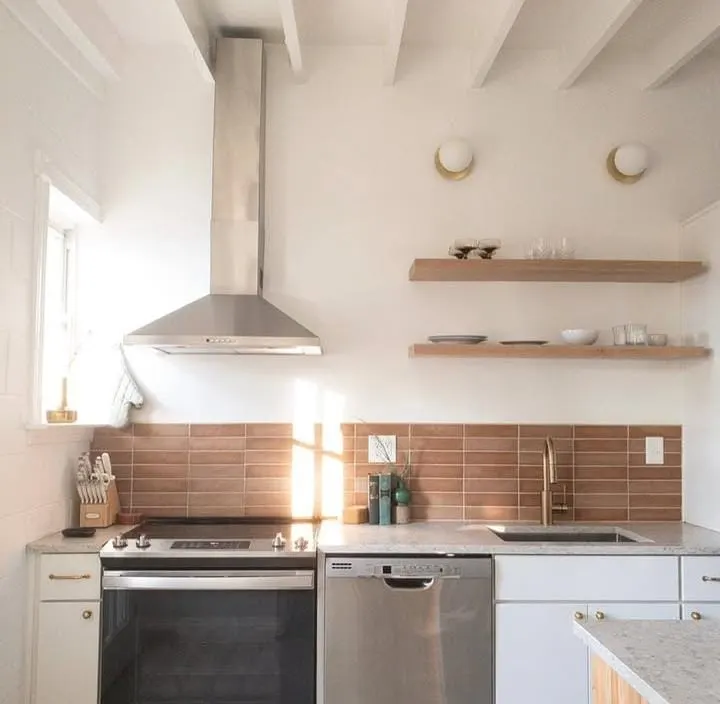
Materials/Tools: Terracotta tiles, grout, tile spacers, tile adhesive, trowel, level, sponge, sealant, measuring tape.
Instructions:
- Measure the backsplash area carefully and plan tile placement.
- Clean the wall surface thoroughly to remove dust.
- Apply tile adhesive evenly using a trowel.
- Press terracotta tiles gently into place, starting from the center.
- Use spacers between tiles for consistent alignment.
- Check each row with a level to keep lines straight.
- Allow adhesive to dry overnight.
- Mix grout and apply between tiles using a rubber float.
- Wipe excess grout with a damp sponge.
- Once dried, apply a sealant to protect the porous terracotta.
- Clean tiles with a soft cloth to reveal their natural texture.
- Add simple wooden shelves above the backsplash.
- Display ceramics or dried herbs for earthy styling.
- Keep lighting warm to enhance the terracotta hue.
- Maintain by resealing every few years for longevity.
Benefits:
Terracotta tiles radiate warmth and authenticity, transforming your kitchen into a rustic Mediterranean retreat. Their imperfect charm, earthy color, and natural texture add depth and coziness without feeling forced or trendy.
Also read: 15 Living Room Paint Color Ideas
2. Open Wooden Shelving

Materials/Tools: Reclaimed wood planks, brackets, drill, screws, anchors, measuring tape, level, sandpaper, stain.
Instructions:
- Choose a reclaimed or raw wood plank for natural character.
- Sand rough edges for a soft, lived-in finish.
- Measure and mark wall positions for brackets.
- Drill pilot holes and insert anchors for support.
- Mount brackets securely.
- Place shelves atop and fix them with screws.
- Stain or oil the wood to enhance its tone.
- Style with handmade pottery, bowls, and glass jars.
- Add small plants or trailing vines.
- Use neutral dishes to keep the palette cohesive.
- Avoid over-styling — leave negative space for airiness.
- Add an LED strip under shelves for subtle light.
- Keep heavy items closer to wall ends for stability.
- Dust shelves weekly to preserve texture.
- Refresh styling seasonally for natural variation.
Benefits:
Open shelving adds an approachable, organic vibe. It encourages minimalism while celebrating natural materials, letting your kitchen feel warm and personal rather than overly styled.
3. Clay Pendant Lights
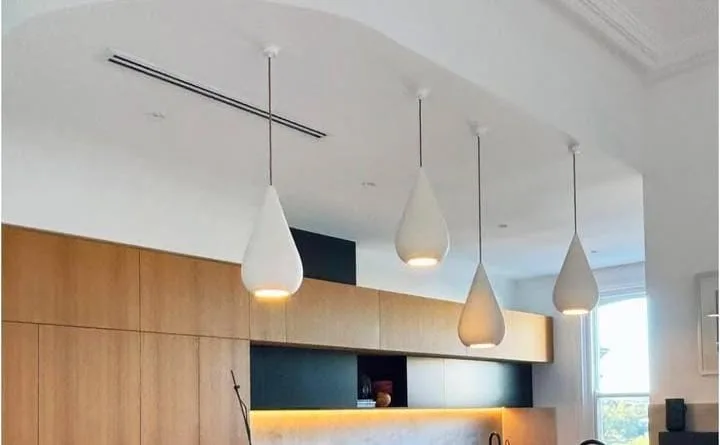
Materials/Tools: Clay pendant fixtures, bulbs (warm white), ceiling hooks, cable kit, drill, screwdriver, ladder.
Instructions:
- Choose pendants with handmade texture — unglazed or matte.
- Turn off power before installation.
- Mark ceiling points for placement above counters or islands.
- Drill holes for ceiling hooks and wiring.
- Install cable kit securely.
- Connect electrical wiring carefully.
- Fix pendant shades to cords and adjust height.
- Use warm white bulbs for soft lighting.
- Clean shades gently with a dry cloth.
- Align multiple pendants for symmetry.
- Use dimmers to control mood.
- Ensure pendant color complements wall tones.
- Pair with wood or stone accents nearby.
- Test lighting during evening for ambiance.
- Maintain regularly for dust-free glow.
Benefits:
Clay pendants cast a warm, organic glow that enhances the kitchen’s earthy tone. Their handmade texture creates character, balancing rustic warmth with minimalist elegance.
4. Stone Countertops with Matte Finish
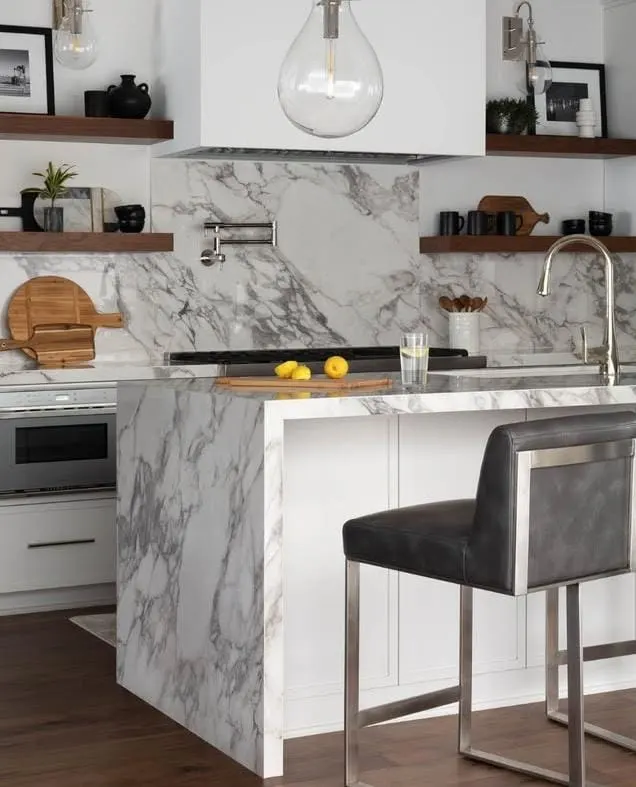
Materials/Tools: Natural stone slab (granite, soapstone, or quartzite), sealant, adhesive, cutting tools, silicone, cloths.
Instructions:
- Measure countertop dimensions precisely.
- Select a matte-finished natural stone for organic texture.
- Remove old countertop surfaces.
- Apply adhesive on cabinet tops.
- Place stone slab carefully, ensuring even placement.
- Seal joints with silicone.
- Allow to set overnight.
- Apply protective sealant to prevent stains.
- Polish edges lightly without removing texture.
- Clean regularly with stone-safe cleaner.
- Avoid acidic substances on surface.
- Pair with wooden cabinets for contrast.
- Use warm metals like brass or bronze for hardware.
- Add small plants or bowls of fruit for color.
- Reseal every 6–12 months for durability.
Benefits:
Matte stone countertops bring understated luxury and authenticity. Their raw finish enhances texture while complementing wood and clay tones for a grounded, tactile look.
5. Olive-Green Cabinetry

Materials/Tools: Paint, primer, sandpaper, rollers, painter’s tape, brushes, sealant.
Instructions:
- Remove cabinet doors and hardware.
- Clean surfaces with degreaser.
- Sand lightly for smooth adhesion.
- Apply primer evenly.
- Paint cabinets with olive-green matte finish.
- Allow to dry completely between coats.
- Seal for protection.
- Reinstall hardware (preferably bronze or black).
- Pair with wood or white countertops.
- Add neutral linens or clay vases.
- Keep backsplash simple to highlight the tone.
- Style with leafy herbs and rustic trays.
- Use soft lighting to emphasize depth.
- Keep lower cabinets darker for grounding.
- Maintain finish with gentle cleaning products.
Benefits:
Olive-green cabinets deliver a grounded, modern-earthy aesthetic. The tone feels cozy yet chic, adding a natural balance that complements both light and dark elements.
6. Natural Fiber Rugs

Materials/Tools: Jute, sisal, or hemp rug, rug pad, vacuum cleaner, rug tape.
Instructions:
- Measure kitchen floor zones needing softness.
- Choose a low-pile jute or sisal rug.
- Place rug pad underneath to prevent slipping.
- Position near sink or under dining nook.
- Align edges neatly with counters.
- Add rug tape for stability.
- Vacuum regularly to remove crumbs.
- Rotate monthly for even wear.
- Spot clean using mild detergent.
- Dry thoroughly to prevent mildew.
- Pair with wooden tones for harmony.
- Avoid placing near heavy spill zones.
- Use natural light to highlight fiber texture.
- Replace every few years for freshness.
- Match with linen curtains or woven baskets.
Benefits:
Natural fiber rugs add warmth and texture, grounding your space while softening hard surfaces. Their neutral tones effortlessly blend with earthy palettes.
7. Clay-Plastered Walls
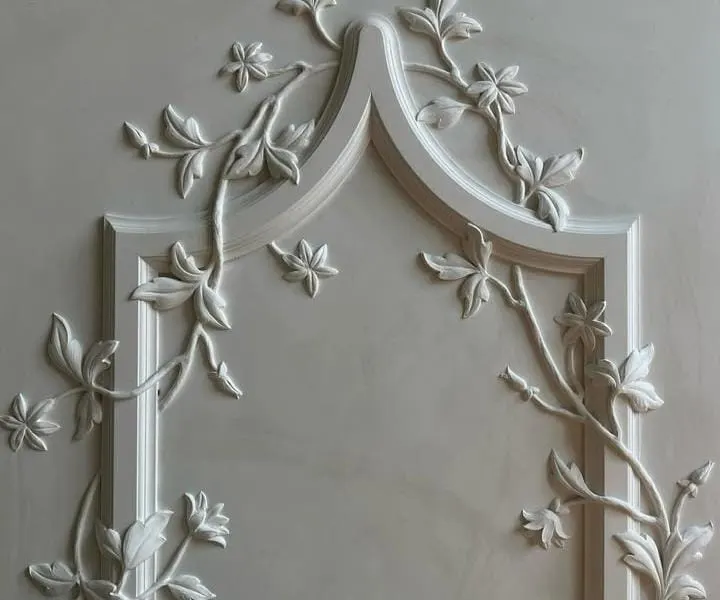
Materials/Tools: Natural clay plaster, mixing bucket, trowel, primer, sponge, sandpaper, sealant (optional).
Instructions:
- Clean walls thoroughly and remove old paint or debris.
- Apply primer suited for clay finishes.
- Mix plaster with water until smooth and thick.
- Use a trowel to spread evenly across the wall surface.
- Start with thin layers, moving in random organic strokes.
- Let the first coat dry fully.
- Apply a second coat for depth and natural variation.
- Use a damp sponge to smooth rough areas.
- Lightly sand for a soft matte texture.
- Seal only if needed for splash zones.
- Allow walls to cure naturally — avoid forced drying.
- Wipe clean gently with a dry cloth.
- Add wooden shelving or hanging herbs as accents.
- Keep lighting warm to emphasize texture.
- Complement with neutral décor for visual calm.
Benefits:
Clay-plastered walls exude a soothing, grounded charm. They regulate moisture, soften acoustics, and introduce authentic handmade warmth — all without looking over-styled or artificial.
8. Rustic Brass Fixtures

Materials/Tools: Brass taps, drawer pulls, screws, screwdriver, microfiber cloth, mild polish.
Instructions:
- Choose unpolished or aged brass finishes.
- Remove existing hardware carefully.
- Clean surfaces before installation.
- Align holes precisely for new fixtures.
- Screw handles or pulls in place securely.
- Install brass faucet and check for leaks.
- Polish lightly to reveal natural sheen.
- Combine brass with wood cabinetry for harmony.
- Avoid pairing with overly shiny metals.
- Clean using only mild soap and soft cloths.
- Let patina age naturally for character.
- Use similar tone in lighting for consistency.
- Add woven mats nearby for balance.
- Integrate with beige or white tones.
- Maintain gently to preserve texture.
Benefits:
Brass introduces quiet luxury without excess. Its soft golden tone complements earthy hues beautifully, adding depth and vintage sophistication that matures gracefully over time.
9. Woven Pendant Lamps
Materials/Tools: Rattan or bamboo pendants, bulb kit, ladder, drill, anchors, hooks.
Instructions:
- Measure ceiling height and mark pendant placement.
- Drill and install ceiling hooks with anchors.
- Feed the cable through the woven shade.
- Connect electrical wiring safely.
- Adjust pendant height above island or table.
- Use warm bulbs for golden glow.
- Space pendants evenly for balance.
- Dust shades regularly with soft brush.
- Replace bulbs with low-heat options.
- Layer multiple pendants for drama.
- Avoid clashing with heavy metal fixtures.
- Add nearby wooden textures for cohesion.
- Highlight natural weaves with spotlights.
- Complement with linen or clay décor.
- Ensure secure hanging and stability.
Benefits:
Woven pendants diffuse light gently, casting organic shadows that feel cozy and intimate. Their natural materials enhance earthy textures and soften the modern kitchen’s geometry.
10. Reclaimed Wood Island
Materials/Tools: Reclaimed wood boards, screws, saw, level, brackets, varnish, sandpaper.
Instructions:
- Select reclaimed wood with visible grain.
- Cut planks to desired island dimensions.
- Assemble base structure using brackets.
- Attach planks securely across top.
- Sand lightly but keep imperfections visible.
- Apply protective varnish for durability.
- Mount wheels for flexible movement if desired.
- Add open shelves underneath for storage.
- Use bar stools with woven seats.
- Place pendant lighting overhead.
- Keep décor simple — ceramic bowls, herbs, linen.
- Avoid glossy finishes that feel artificial.
- Maintain with natural oil polish occasionally.
- Combine with matte counters for balance.
- Ensure sturdy alignment before regular use.
Benefits:
A reclaimed wood island anchors your space with character and history. The worn texture contrasts beautifully with clean modern lines, offering warmth, depth, and sustainability.
11. Stone or Concrete Sink
Materials/Tools: Stone or concrete sink basin, sealant, silicone, wrench, plumber’s tape, adhesive.
Instructions:
- Choose sink type suited for your counter cutout.
- Remove old sink and clean the area.
- Apply silicone sealant around edge.
- Lower stone sink carefully into place.
- Connect plumbing lines and tighten with wrench.
- Seal seams for waterproof protection.
- Allow sealant to cure overnight.
- Test drainage for smooth flow.
- Polish stone gently with a soft cloth.
- Keep faucet minimal for balance.
- Decorate with a small potted herb nearby.
- Use natural dish brushes to complement look.
- Clean using pH-neutral soap only.
- Avoid acidic cleaners that damage surface.
- Reseal yearly for preservation.
Benefits:
A stone sink adds sculptural beauty and grounded presence. It’s functional yet organic, blending seamlessly into earthy designs and evoking artisanal craftsmanship.
12. Linen Curtains or Roman Shades
Materials/Tools: Linen fabric, curtain rod or shade kit, scissors, iron, sewing kit or adhesive hem tape.
Instructions:
- Measure window width and height precisely.
- Cut linen fabric with extra inches for hems.
- Iron fabric to remove wrinkles.
- Sew or press hem edges neatly.
- Install curtain rod or Roman shade mount.
- Attach linen panels or shade to hardware.
- Test movement and alignment.
- Keep color palette neutral — ivory, beige, or clay.
- Wash occasionally in cold water.
- Iron on low heat for crisp finish.
- Layer with sheer fabric if more privacy needed.
- Add small tiebacks of jute for rustic charm.
- Pair with woven rugs for harmony.
- Let sunlight filter gently through texture.
- Refresh fabric every few seasons.
Benefits:
Linen curtains soften natural light and introduce an airy calm. Their organic weave and muted hues add effortless elegance, making the space feel relaxed and connected to nature.
13. Herb Wall Garden
Materials/Tools: Wooden frame, small pots, soil, herbs (basil, thyme, rosemary), hooks, watering can.
Instructions:
- Choose a sunlit kitchen wall.
- Mount a sturdy wooden or metal frame.
- Attach small pots using hooks or clamps.
- Fill each pot with quality soil mix.
- Plant herbs suitable for indoor growth.
- Water lightly but regularly.
- Arrange herbs at different heights for texture.
- Label pots with chalk or tags.
- Add grow light if natural light is limited.
- Harvest gently for cooking use.
- Replace herbs seasonally for freshness.
- Keep soil drained to prevent mold.
- Wipe frame clean weekly.
- Coordinate pot colors with kitchen palette.
- Enjoy natural fragrance daily.
Benefits:
A living herb wall merges décor and function, breathing freshness into your space. It keeps your kitchen visually alive while supporting sustainable, organic cooking.
14. Earth-Toned Dinnerware Display
Materials/Tools: Open shelves or glass cabinet, ceramic plates and mugs in neutral hues, organizer stands.
Instructions:
- Select ceramics in beige, clay, and stone colors.
- Arrange them visibly on open shelves.
- Use wooden risers for tiered presentation.
- Stack dishes neatly by color family.
- Mix matte and glazed textures for interest.
- Leave some negative space to avoid clutter.
- Add subtle lighting under shelves.
- Rotate items seasonally.
- Keep surfaces dust-free.
- Incorporate handmade pottery for authenticity.
- Pair with wooden trays or woven baskets.
- Ensure tones coordinate with cabinetry.
- Replace broken pieces promptly for cohesion.
- Use everyday items as display objects.
- Avoid overly bright or artificial colors.
Benefits:
Displaying earth-toned ceramics celebrates craftsmanship and adds natural artistry. It visually connects your kitchen to the organic charm of simple, handmade beauty.
15. Raw Wood Open Beams
Materials/Tools: Reclaimed timber beams, brackets, screws, drill, level, sealant.
Instructions:
- Inspect ceiling structure for load capacity.
- Mark beam placement lines.
- Cut reclaimed timber to fit.
- Sand lightly to maintain rustic texture.
- Secure metal brackets to ceiling joists.
- Lift beams into position with help.
- Screw beams firmly into brackets.
- Fill gaps with wood filler if needed.
- Apply matte sealant to preserve tone.
- Install recessed lighting between beams.
- Clean occasionally with dry cloth.
- Keep ceiling paint neutral to highlight beams.
- Add hanging plants or baskets near edges.
- Check stability yearly.
- Enjoy the architectural contrast.
Benefits:
Raw beams add organic strength and warmth, defining the space while keeping it airy. They’re timeless anchors that balance modern simplicity with natural charm.
16. Neutral Clay Paint Finish
Materials/Tools: Clay paint, roller, brush, drop cloths, painter’s tape, primer.
Instructions:
- Prepare walls by cleaning thoroughly.
- Apply primer compatible with clay paint.
- Stir paint gently for uniform texture.
- Use a roller for even coverage.
- Apply two coats for rich matte depth.
- Brush corners manually for detail.
- Let each coat dry naturally.
- Avoid gloss finishes.
- Choose hues like sand, wheat, or mushroom.
- Pair with darker trims for definition.
- Clean surfaces gently — no harsh scrubbing.
- Recoat as needed after a few years.
- Add warm lighting to accent undertones.
- Coordinate with wooden décor.
- Step back and enjoy the softness.
Benefits:
Clay paint absorbs light beautifully, giving walls a velvety, natural tone. It’s non-toxic, breathable, and perfectly complements an earthy palette.
17. Wicker Storage Baskets
Materials/Tools: Wicker baskets, shelves or under-counter space, cloth liners, labels.
Instructions:
- Measure available shelf or floor space.
- Choose baskets in neutral or honey tones.
- Line interiors with washable cloth.
- Store fruits, linens, or utensils.
- Label baskets neatly for organization.
- Mix sizes for dynamic texture.
- Stack vertically to save space.
- Clean baskets with a soft brush monthly.
- Avoid moisture exposure.
- Add handles for easy movement.
- Coordinate with wooden furniture.
- Combine with jute mats or pottery.
- Keep arrangement symmetrical.
- Replace worn liners occasionally.
- Maintain simplicity for visual calm.
Benefits:
Wicker baskets add tactile warmth and practical storage. They blend seamlessly with natural materials, maintaining function without breaking the organic rhythm.
18. Warm Wooden Flooring
Materials/Tools: Engineered hardwood planks, nails, underlayment, hammer, saw, adhesive.
Instructions:
- Remove old flooring and clean subfloor.
- Install underlayment for sound insulation.
- Lay wooden planks starting from one wall.
- Apply adhesive or nail securely.
- Use spacers for expansion gaps.
- Stagger seams for natural look.
- Trim edges neatly.
- Apply matte finish for understated elegance.
- Avoid high gloss to keep earthy tone.
- Clean with wood-safe cleaner.
- Add woven rugs for warmth.
- Use felt pads under furniture.
- Reseal every few years.
- Pair with beige or olive walls.
- Enjoy timeless, natural comfort.
Benefits:
Warm wooden floors set the foundation for a calm, nature-inspired kitchen. They connect visually with every other material, grounding the entire design.
19. Stone Accent Wall
Materials/Tools: Thin stone veneer, mortar, trowel, level, sponge, sealant.
Instructions:
- Choose wall for feature — behind stove or breakfast nook.
- Clean and prep surface.
- Apply mortar evenly.
- Press stone veneers firmly, starting from bottom.
- Use level to align rows.
- Fill joints with mortar.
- Smooth excess with sponge.
- Allow to dry overnight.
- Seal with protective finish.
- Highlight with directed lighting.
- Keep surrounding décor simple.
- Avoid overcrowding textures.
- Complement with wooden shelves.
- Dust gently to retain patina.
- Relish the organic statement.
Benefits:
A stone accent wall brings tactile depth and rustic sophistication. It creates a dramatic focal point while keeping the palette natural and balanced.
20. Earth-Inspired Accessories
Materials/Tools: Ceramic vases, woven trays, stone bowls, dried flowers, clay sculptures.
Instructions:
- Select a few key natural accessories.
- Group items by texture, not color.
- Display on shelves or countertops.
- Keep symmetry loose and natural.
- Mix matte ceramics with woven trays.
- Use dried flowers or grasses for height.
- Rotate décor seasonally.
- Avoid clutter — less is more.
- Add small candles in neutral holders.
- Coordinate tones with flooring and cabinets.
- Maintain with gentle cleaning.
- Replace items gradually for freshness.
- Keep visual focus on organic silhouettes.
- Layer with soft linen runners.
- Step back and let simplicity shine.
Benefits:
Thoughtful natural accents tie the entire design together. They express personality, warmth, and authenticity — proving true beauty lies in restraint and nature’s honesty.
Conclusion
Creating an earthy kitchen isn’t about following trends — it’s about building a sanctuary that feels timeless and alive. Each texture, hue, and imperfection tells a story, creating a space that welcomes and inspires. Whether through terracotta tiles, reclaimed wood, or brass fixtures, the goal is balance — between modern design and nature’s authenticity.
So, before your next kitchen update, pause and imagine the space breathing — sunlit, grounded, textured. Save these 20 earthy kitchen ideas to your inspiration board, and let your home evolve naturally. For more soulful décor guides, explore our latest design inspirations and keep creating spaces that feel truly you.

